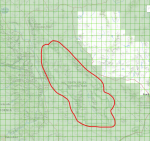ducktapeguy
Adventurer
[/QUOTE]
Agree 100%. A topo map can give you an overall sense of the terrain, but even the best map will not tell you whether or not an area is passable or impassable. There are plenty of places that look worse on a map, but are easily hikeable, and other areas where a map can't convey the difficulty.
A maps has gotten me into trouble as often as it has gotten me out of trouble. Maybe I'm not the best map reader, but a map can only tell me if the terrain is steep, but it can't tell me if there's an easy path down that terrain or if it's completely undoable without special equipment. It's similar to a trail map off road, without any rating systems or trip reports, a map alone can't tell you how difficult the trail is. Also, things can change year to year or even month to month, especially in desert canyons. What could have previously been a relatively simple hike could become a technical canyon, and vice versa.
Most people in DV aren't going to be carrying a 7.5 minute topo map unless they are going to a very specific area and need that level of detail, i.e. canyoning in a specific canyon. What some people might not understand is DV is huge, over 3 million acres. Carrying a 7.5 minute topo map is like inspecting a house with a microscope. What most people will carry is probably the National Park Map, or if they're a little more prepared, the Tom Harrison map linked above. Neither of those maps would indicate that Willow canyon is impassable by foot. Only through the luxury of hindsight, sitting at a computer looking at satellite views, google earth, and reading past trip reports, AND knowing 2 people died there, are people able to come to the conclusion that the path from Gold Valley to Badwater wasn't doable. Even with Google satellite view, and having hiked in that area, when looking at the area they were in I wouldn't have immediately assume that Willow canyon was a technical canyon. It's not until you read first hand trip reports that you would know it can't be hiked easily. Had they gone a 1/4 mile north or south, there's a really good chance they would have made it to the bottom and this story would have had a different outcome.
I would argue that while the USGS maps are not inherently inaccurate, they don't take into account 100% of everything. They simply cannot. Not at a 1:24,000 scale. They show gross elevation and elevation changes, vegetation, overlay, some water features, and large man made objects of importance. You can get a really good sense of what you are up against, but you don't get the full picture.
Agree 100%. A topo map can give you an overall sense of the terrain, but even the best map will not tell you whether or not an area is passable or impassable. There are plenty of places that look worse on a map, but are easily hikeable, and other areas where a map can't convey the difficulty.
It's really pretty simple: There is no complete substitute for a map, a compass, and the skills to use them. Heading off into unknown territory without them in inherently risky.
Foy
A maps has gotten me into trouble as often as it has gotten me out of trouble. Maybe I'm not the best map reader, but a map can only tell me if the terrain is steep, but it can't tell me if there's an easy path down that terrain or if it's completely undoable without special equipment. It's similar to a trail map off road, without any rating systems or trip reports, a map alone can't tell you how difficult the trail is. Also, things can change year to year or even month to month, especially in desert canyons. What could have previously been a relatively simple hike could become a technical canyon, and vice versa.
Most people in DV aren't going to be carrying a 7.5 minute topo map unless they are going to a very specific area and need that level of detail, i.e. canyoning in a specific canyon. What some people might not understand is DV is huge, over 3 million acres. Carrying a 7.5 minute topo map is like inspecting a house with a microscope. What most people will carry is probably the National Park Map, or if they're a little more prepared, the Tom Harrison map linked above. Neither of those maps would indicate that Willow canyon is impassable by foot. Only through the luxury of hindsight, sitting at a computer looking at satellite views, google earth, and reading past trip reports, AND knowing 2 people died there, are people able to come to the conclusion that the path from Gold Valley to Badwater wasn't doable. Even with Google satellite view, and having hiked in that area, when looking at the area they were in I wouldn't have immediately assume that Willow canyon was a technical canyon. It's not until you read first hand trip reports that you would know it can't be hiked easily. Had they gone a 1/4 mile north or south, there's a really good chance they would have made it to the bottom and this story would have had a different outcome.
Last edited:

